Preparation and Mechanical Properties of Microcapsule-Based Self-Healing Cementitious Composites
Abstract
:1. Introduction
2. Materials and Methods
2.1. Microcapsule Preparation
- (1)
- Wet material preparation: The specific gravity of the water in wet material is 30%. The powder is comprised of Portland cement, ground sodium silicate, microcrystalline cellulose, and methyl cellulose mixed evenly in proportion with a cement mortar mixer. Distilled water and TWEEN 80 required by the proportion of humidity are evenly vibrated by an ultrasonic oscillator and rapidly mixed to ensure the proper humidity.
- (2)
- Extrusion and spheronization: The prepared wet material is slowly poured into a running extrusion system. After extrusion, it falls directly into a working spheronizer. The rotational speed of the spheronizer is controlled between 500–1000 revolutions. The interruption system and centrifugal effect of the spheronizer gradually interrupt the extruded cylindrical strip, then spheronizes and spheroidizes it. In the extrusion process, the diameter of the small holes in the sieve plate is set to about 1 mm to control the bottom diameter of the extruded strip product.
- (3)
- Coating: The ethyl cellulose powder is dissolved in the mixed solution of xylene and ethanol in the proportions necessary to form a coating solution. The material is sprayed into a roller with a spray gun, then the rotation speed of the spheronizer is reduced until it is stopped once most of the microcapsules have a significant luster and make a crisp sound upon impact. When the package is finished, the material is completely dried at a temperature of 30 °C. The microcapsule prepared by this method has sufficient encapsulation and strength to satisfy the working mechanism of microcapsule self-healing concrete.
- (4)
- Screening process: Microcapsules with certain defects or oversize particles are screened out to retain only those 1.25–1.5 mm in size.
2.2. Composite Preparation
- (1)
- (2)
- Fine aggregate: Chinese ISO standard sand was used with a fineness modulus of 2.4.
- (3)
- Curing agent: Analytical pure sodium fluorosilicate, potassium fluorosilicate, and magnesium fluorosilicate (Sinopharm Chemical Reagent Co., Ltd., Shanghai, China) were used. The preparation time of these three different curing agents is denoted as FNA, FK, and FMG, respectively.
- (4)
- Water: Ordinary tap water from Zhenjiang Jiangsu was used. The pH of the water is about 6.5.
2.3. Tests for Mechanical Properties and Strength Recovery
3. Morphology and Composition of Microcapsules
4. Mechanical Properties of Microcapsule-Based Self-Healing Cementitious Composites
4.1. Effects of Microcapsule Content on Compressive and Flexural Strength
4.2. Effects of Microcapsule Content on Secondary Compressive Strength of Composites
5. Strength Healing Performance of Self-Healing Cementitious Composites
5.1. Before and After Healing
5.2. Effect of Curing Agent on Strength Healing Property of Composites
5.3. Effects of Age and Healing Time on Strength and Healing Properties of Composites
6. Conclusions
- (1)
- The microencapsulated self-healing mortar specimens prepared in the experiment showed strong healing performance. The strength healing rate obtained by secondary compression was higher than that of ordinary mortar specimens. The specimen may retain a certain amount of secondary compressive strength at up to 70–80% of the original compressive strength.
- (2)
- The microcapsules and curing agent enhanced the flexural and compressive strength of mortar specimens at relatively low contents. The optimal microcapsule content in terms of compressive strength is 1–3%. When the microcapsule content reached 7%, the strength of the specimen decreased by about 30%.
- (3)
- Sodium fluorosilicate is better suited to the microcapsule self-healing cement-based system than the other two fluorosilicates tested in this study. Potassium fluorosilicate and magnesium fluorosilicate as curing agents showed similarly poor healing performance. Sodium fluorosilicate is an effective curing agent that should be prioritized for further development. The self-healing rate of mortar samples with FNA as a curing agent is 20–50% under the condition of 1–5%, which is about 40% higher than that of ordinary mortar.
- (4)
- Healing time significantly influenced the self-healing system of the microcapsule. Mortar specimens repaired for 28 days performed significantly better than those healed for 7 days.
Author Contributions
Funding
Institutional Review Board Statement
Informed Consent Statement
Data Availability Statement
Conflicts of Interest
References
- Su, J.; Han, S.; Wang, Y.; Schlangen, E.; Han, N.; Liu, B.; Zhang, X.; Yang, P.; Li, W. Experimental observation of the self-healing microcapsules containing rejuvenator states in asphalt binder. Constr. Build. Mater. 2017, 147, 533–542. [Google Scholar] [CrossRef]
- Davies, R.; Jefferson, A. Micromechanical modelling of self-healing cementitious materials. Int. J. Solids Struct. 2017, 113–114, 180–191. [Google Scholar] [CrossRef]
- Van Stappen, J.; Bultreys, T.; Gilabert, F.A.; Hillewaere, X.K.D.; Gómez, D.G.; Van Tittelboom, K.; Dhaene, J.; De Belie, N.; Van Paepegem, W.; Du Prez, F.E.; et al. The microstructure of capsule containing self-healing materials: A micro-computed tomography study. Mater. Charact. 2016, 119, 99–109. [Google Scholar] [CrossRef] [Green Version]
- Lv, L.; Yang, Z.; Chen, G.; Zhu, G.; Han, N.; Schlangen, E.; Xing, F. Synthesis and characterization of a new polymeric microcapsule and feasibility investigation in self-healing cementitious materials. Constr. Build. Mater. 2016, 105, 487–495. [Google Scholar] [CrossRef]
- Kim, H.; Son, H.M.; Seo, J.; Lee, H.K. Recent advances in microbial viability and self-healing performance in bacterial-based cementitious materials: A review. Constr. Build. Mater. 2021, 274, 122094. [Google Scholar] [CrossRef]
- Zuo, J.; Li, H.; Zhan, J.; Dong, B.; Wang, L.; Chen, D. Preparation and properties of cement mortar/metal hydroxide microcapsules composites. Cem. Concr. Compos. 2020, 105, 103438. [Google Scholar] [CrossRef]
- Tian, Y.; Zheng, M.; Li, P.; Zhang, J.; Qiao, R.; Cheng, C.; Xu, H. Preparation and characterization of self-healing microcapsules of asphalt. Constr. Build. Mater. 2020, 263, 120174. [Google Scholar] [CrossRef]
- Zhang, W.; Zheng, Q.; Ashour, A.; Han, B. Self-healing cement concrete composites for resilient infrastructures: A review. Compos. Part B Eng. 2020, 189, 107892. [Google Scholar] [CrossRef]
- Nalbandian, K.M.; Carpio, M.; González, Á. Analysis of the scientific evolution of self-healing asphalt pavements: Toward sustainable road materials. J. Clean. Prod. 2021, 293, 126107. [Google Scholar] [CrossRef]
- Liang, B.; Lan, F.; Shi, K.; Qian, G.; Liu, Z.; Zheng, J. Review on the self-healing of asphalt materials: Mechanism, affecting factors, assessments and improvements. Constr. Build. Mater. 2021, 266, 120453. [Google Scholar] [CrossRef]
- Ramm, W.; Biscoping, M. Autogenous healing and reinforcement corrosion of water-penetrated separation cracks in reinforced concrete. Nucl. Eng. Des. 1998, 179, 191–200. [Google Scholar] [CrossRef]
- Yu, Z.; Yang, Y.; Yan, Y. Autogenous self-healing of engineered cementitious composites under freeze–thaw cycles. Constr. Build. Mater. 2012, 34, 522–530. [Google Scholar]
- Sukontasukkul, P.; Intawong, E.; Preemanoch, P.; Chindaprasirt, P. Use of paraffin impregnated lightweight aggregates to improve thermal properties of concrete panels. Mater. Struct. 2016, 49, 1793–1803. [Google Scholar] [CrossRef]
- Song, Y.K.; Lee, K.H.; Kim, D.M.; Chung, C.M. A microcapsule-type fluorescent probe for the detection of microcracks in cementitious materials. Sens. Actuators B Chem. 2016, 222, 1159–1165. [Google Scholar] [CrossRef]
- Wang, X.; Huang, Y.; Huang, Y.; Zhang, J.; Fang, C.; Yu, K.; Chen, Q.; Li, T.; Han, R.; Yang, Z. Laboratory and field study on the performance of microcapsule-based self-healing concrete in tunnel engineering. Constr. Build. Mater. 2019, 220, 90–101. [Google Scholar] [CrossRef]
- Al-Tabbaa, A.; Litina, C.; Giannaros, P.; Kanellopoulos, A.; Souza, L. First UK field application and performance of microcapsule-based self-healing concrete. Constr. Build. Mater. 2019, 208, 669–685. [Google Scholar] [CrossRef]
- Han, T.; Wang, X.; Li, D.; Li, D.; Xing, F.; Han, N.; Li, Z. Uniaxial deformation characteristics and mechanical model of microcapsule-based self-healing cementitious composite. Constr. Build. Mater. 2021, 274, 121227. [Google Scholar] [CrossRef]
- Jiang, W.; Zhou, G.; Wang, C.; Xue, Y.; Niu, C. Synthesis and self-healing properties of composite microcapsule based on sodium alginate/melamine-phenol–formaldehyde resin. Constr. Build. Mater. 2021, 271, 121541. [Google Scholar] [CrossRef]
- Salman, R.T.; Othman, F.M.; Abdul-Hamead, A.A. Experimental investigation of cement encapsulated with different polymers for self-healing applications. Mater. Today Proc. 2021, 42, 1941–1945. [Google Scholar] [CrossRef]
- Maddalena, R.; Taha, H.; Gardner, D. Self-healing potential of supplementary cementitious materials in cement mortars: Sorptivity and pore structure. Dev. Built Environ. 2021, 6, 100044. [Google Scholar] [CrossRef]
- Zhang, H.; Qi, C.; Chen, W.; Li, Q.; Wu, L.; Chen, W. A novel method of self-healing cement paste by using gel microparticles encapsulating phosphate. Constr. Build. Mater. 2021, 279, 122439. [Google Scholar] [CrossRef]
- Han, T.; Wang, X.; Li, D.; Li, D.; Xing, F.; Han, N. Influence of strain rate on mechanical characteristic and pore structure of self-healing cementitious composites with epoxy/urea-formaldehyde microcapsules. Constr. Build. Mater. 2021, 268, 121138. [Google Scholar] [CrossRef]
- Dry, C. Procedures developed for self-repair of polymer matrix composite materials. Compos. Struct. 1996, 35, 263–269. [Google Scholar] [CrossRef]
- Dry, C.; Mcmillan, W. Three-part methylmethacrylate adhesive system as an internal delivery system for smart responsive concrete. Smart Mater. Struct. 1999, 5, 297. [Google Scholar] [CrossRef]
- Beglarigale, A.; Eyice, D.; Seki, Y.; Yalçınkaya, Ç.; Çopuroğlu, O.; Yazıcı, H. Sodium silicate/polyurethane microcapsules synthesized for enhancing self-healing ability of cementitious materials: Optimization of stirring speeds and evaluation of self-healing efficiency. J. Build. Eng. 2021, 39, 102279. [Google Scholar] [CrossRef]
- Zhan, Q.; Zhou, J.; Wang, S.; Su, Y.; Liu, B.; Yu, X.; Pan, Z.; Qian, C. Crack self-healing of cement-based materials by microorganisms immobilized in expanded vermiculite. Constr. Build. Mater. 2021, 272, 121610. [Google Scholar] [CrossRef]
- Toohey, K.S.; Sottos, N.R.; Lewis, J.A.; Moore, J.S.; White, S.R. Self-healing materials with microvascular networks. Nat. Mater. 2007, 6, 581–585. [Google Scholar] [CrossRef] [PubMed]
- Hansen, C.J.; Wu, W.; Toohey, K.S.; Sottos, N.R.; White, S.R.; Lewis, J.A. Self-healing materials with interpenetrating microvascular networks. Adv. Mater. 2009, 21, 4143–4147. [Google Scholar] [CrossRef]
- Idumah, C.I.; Nwuzor, I.; Odera, S.S. Recent advancements in self-healing polymeric hydrogels, shape memory, and stretchable materials. Int. J. Polym. Mater. Polym. Biomater. 2020, 70, 941–966. [Google Scholar] [CrossRef]
- Kim, D.; Yu, H.; Yang, H.; Cho, Y.; Lee, K.; Chung, C. Microcapsule-type self-healing protective coating for cementitious composites with secondary crack preventing ability. Materials 2017, 10, 114. [Google Scholar] [CrossRef] [Green Version]
- Li, W.; Zhu, X.; Zhao, N.; Jiang, Z. Preparation and properties of melamine urea-formaldehyde microcapsules for self-healing of cementitious materials. Materials 2016, 9, 152. [Google Scholar] [CrossRef] [PubMed] [Green Version]
- Wang, Y.; Lin, Z.; Tang, C.; Hao, W. Influencing factors on the healing performance of microcapsule self-healing concrete. Materials 2021, 14, 4139. [Google Scholar] [CrossRef]
- Beglarigale, A.; Seki, Y.; Demir, N.Y.; Yazıcı, H. Sodium silicate/polyurethane microcapsules used for self-healing in cementitious materials: Monomer optimization, characterization, and fracture behavior. Constr. Build. Mater. 2018, 162, 57–64. [Google Scholar] [CrossRef]
- Van Tittelboom, K.; De Belie, N.; Van Loo, D.; Jacobs, P. Self-healing efficiency of cementitious materials containing tubular capsules filled with healing agent. Cem. Concr. Compos. 2011, 33, 497–505. [Google Scholar] [CrossRef]
- Esser-Kahn, A.P. Programmable microcapsules from self-immolative polymers. J. Am. Chem. Soc. 2010, 132, 10266–10268. [Google Scholar] [CrossRef] [PubMed]
- Brown, E.N.; White, N. Fracture testing of a self-healing polymer composite. Exp. Mech. 2002, 42, 372–379. [Google Scholar] [CrossRef]
- Wang, J.; Chen, S. Preparation and characterization of microcapsules containing capsaicin. J. Appl. Polym. Sci. 2010, 116, 2234–2241. [Google Scholar]
- Kim, J.C.; Lee, H.Y.; Mi, H.K.; Lee, H.J.; Kang, H.Y.; Sang, M.K. Preparation and characterization of chitosan/gelatin microcapsules containing triclosan. Colloids Surf. B Biointerfaces 2006, 52, 52–56. [Google Scholar] [CrossRef]
- Park, S.J.; Kim, S.H. Preparation and characterization of biodegradable poly(l-lactide)/poly(ethylene glycol) microcapsules containing erythromycin by emulsion solvent evaporation technique. J. Colloid Interface Sci. 2004, 271, 336–341. [Google Scholar] [CrossRef]
- Bai, Y.; Cao, G.; Nan, X.; Li, S.; Wang, Z. Effect of sodium fluosilicate particles in acidification flowback fluid on emulsification stability of crude oil. J. Pet. Sci. Eng. 2021, 202, 108484. [Google Scholar] [CrossRef]
- Wang, R.Q. The sucrose-natural gypsum makes the compound retarder to the cement and the concretes performance influence experimental study. Adv. Mater. Res. 2011, 335–336, 1219–1222. [Google Scholar] [CrossRef]
- Yaar, E.; Erdoan, Y.; Kl, A. Effect of limestone aggregate type and water–cement ratio on concrete strength. Mater. Lett. 2004, 58, 772–777. [Google Scholar] [CrossRef]
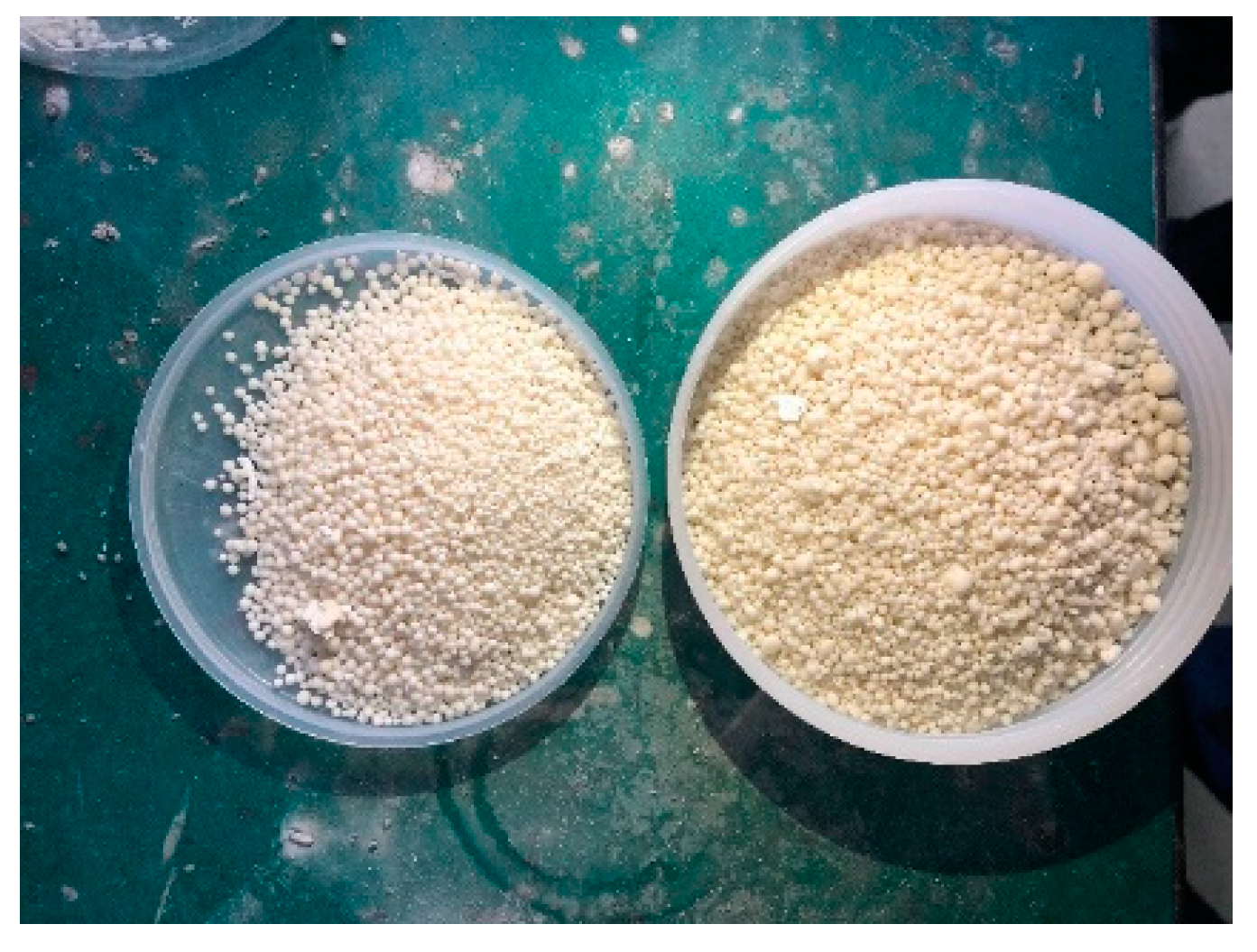
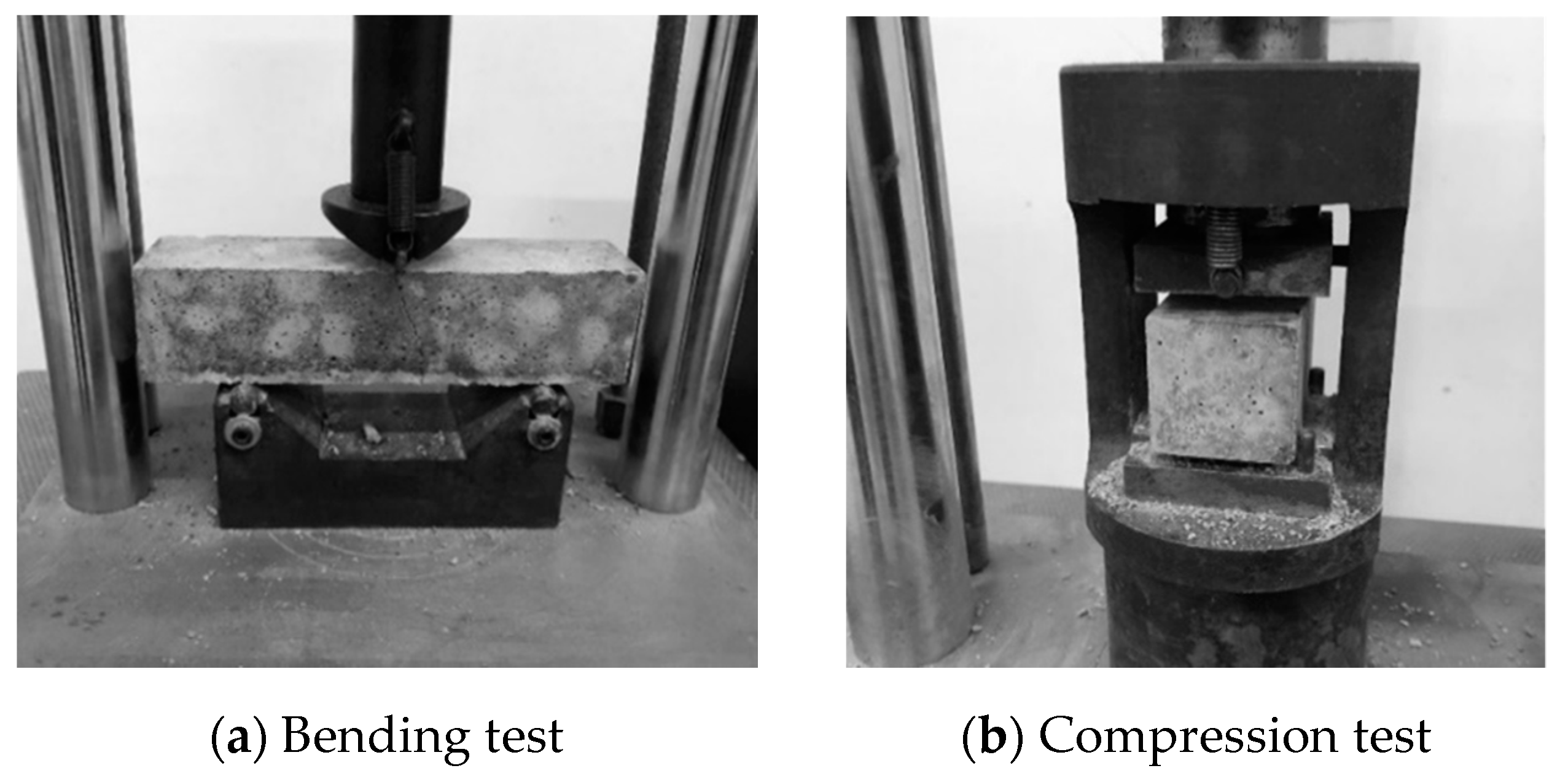
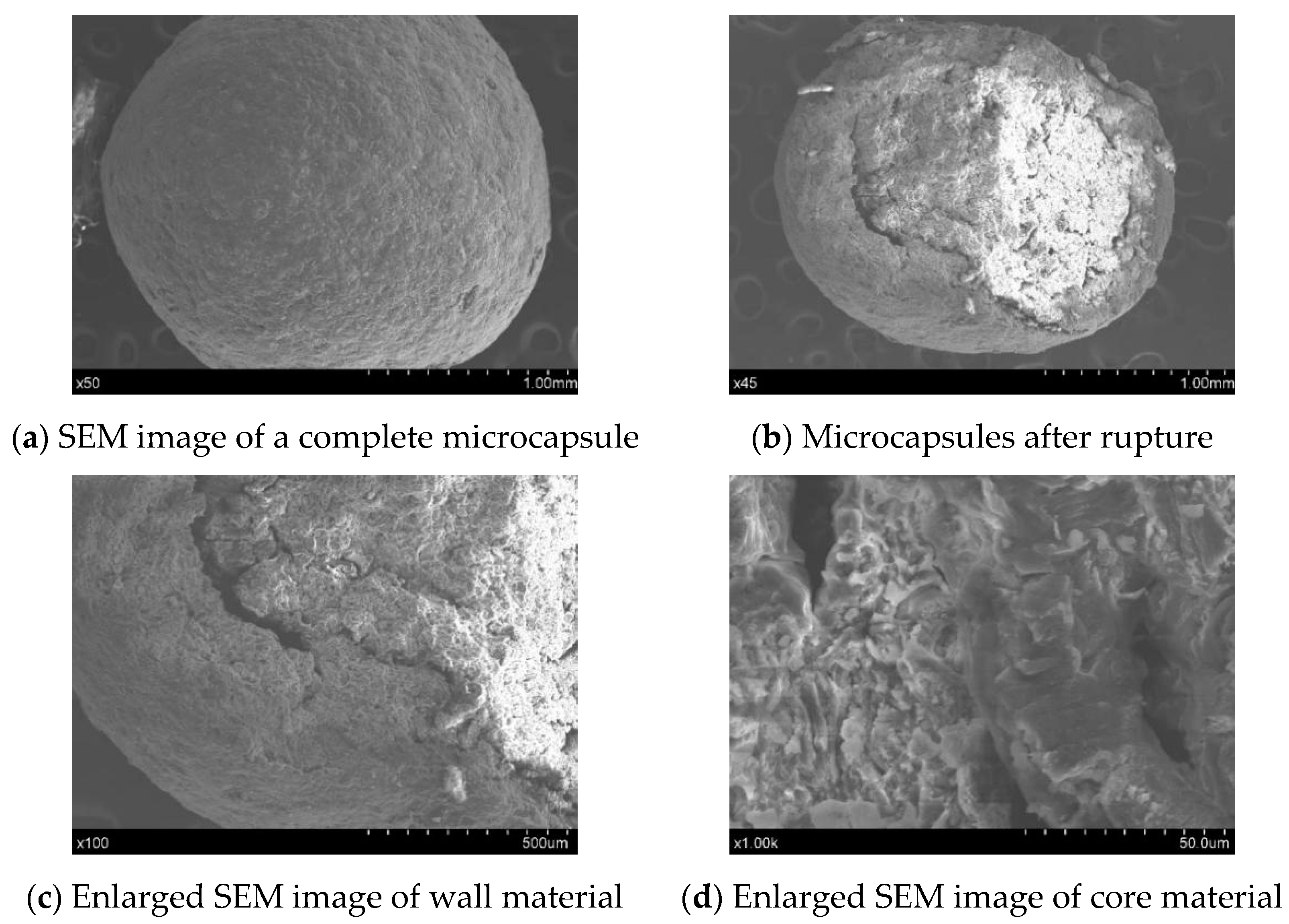

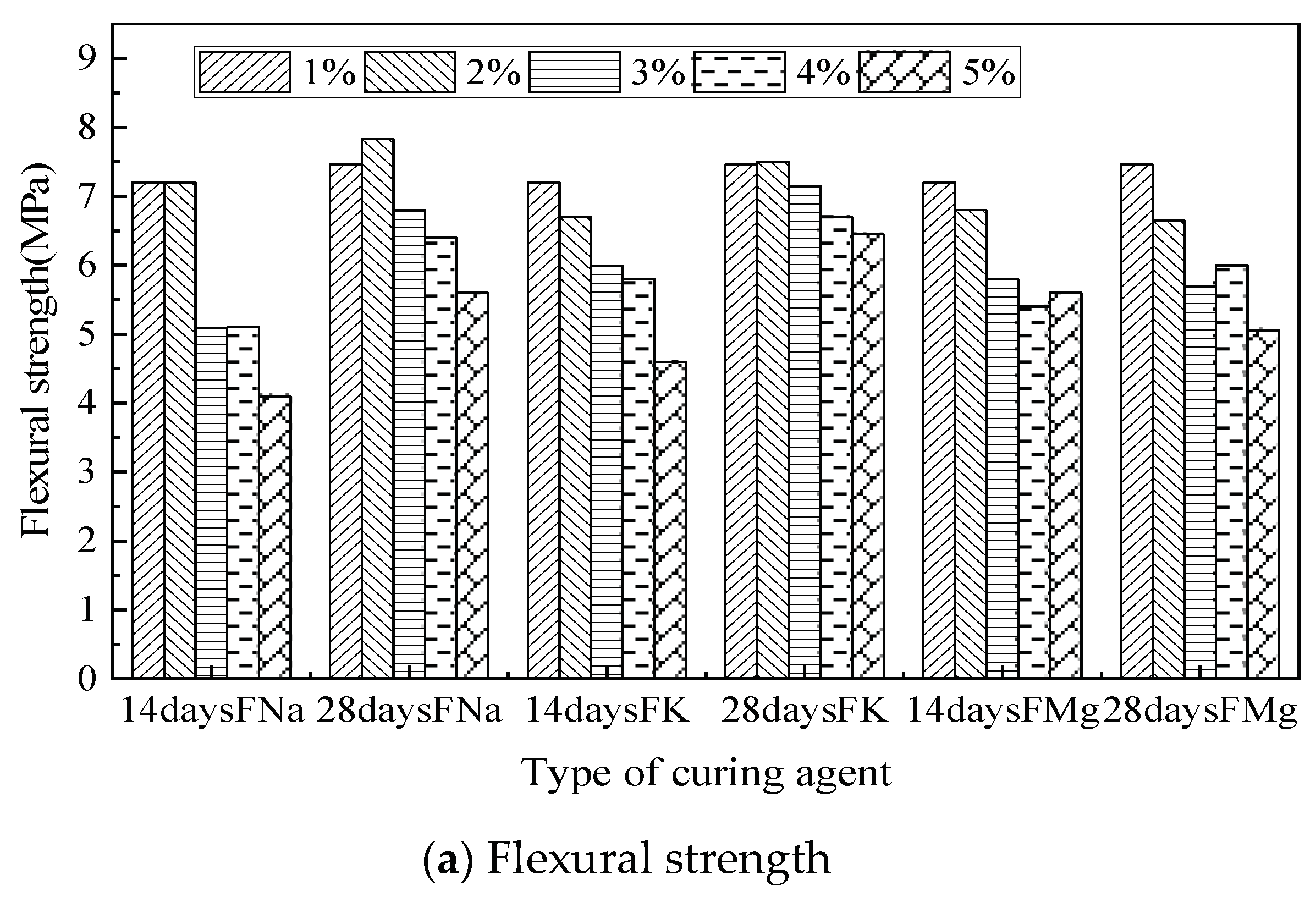
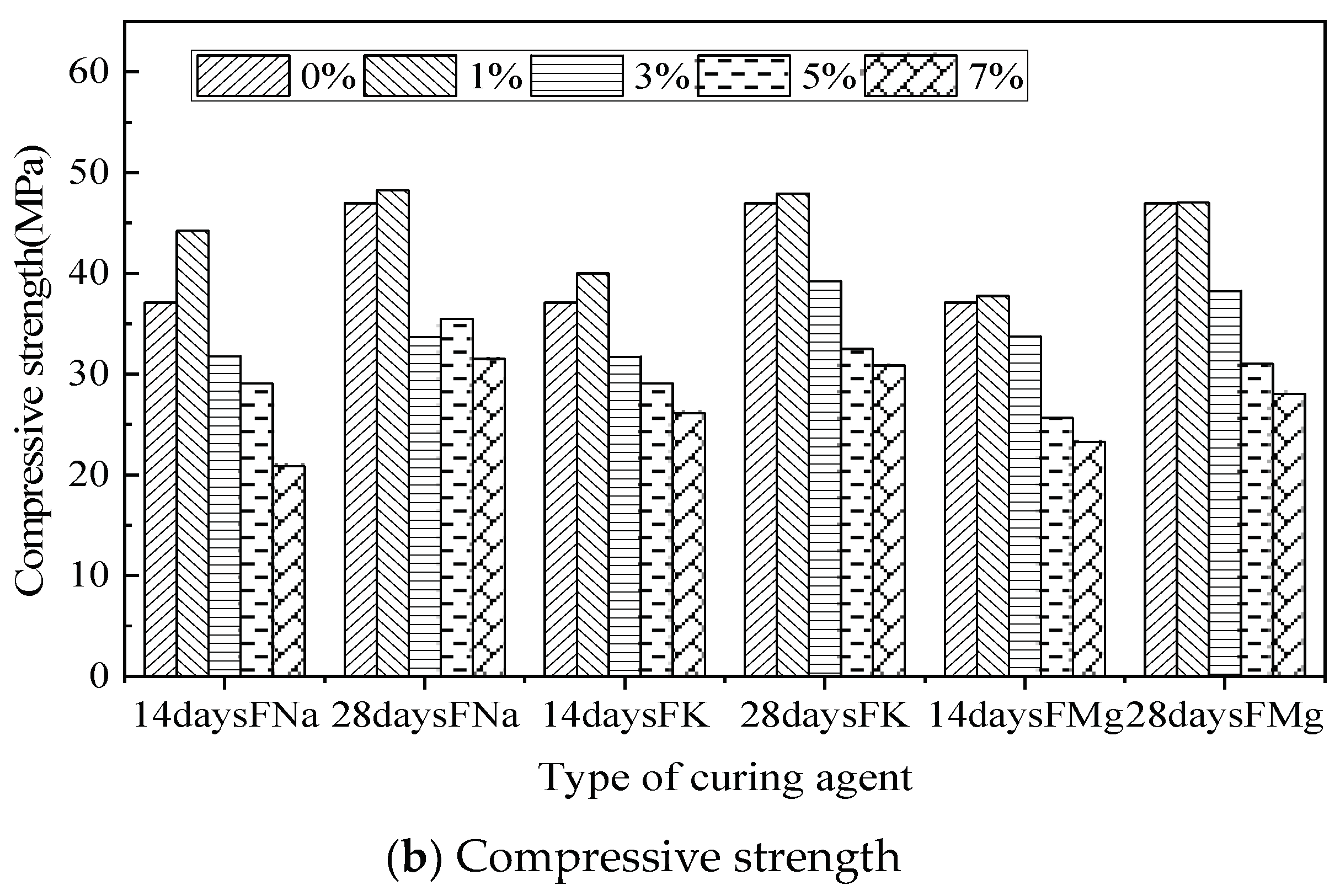
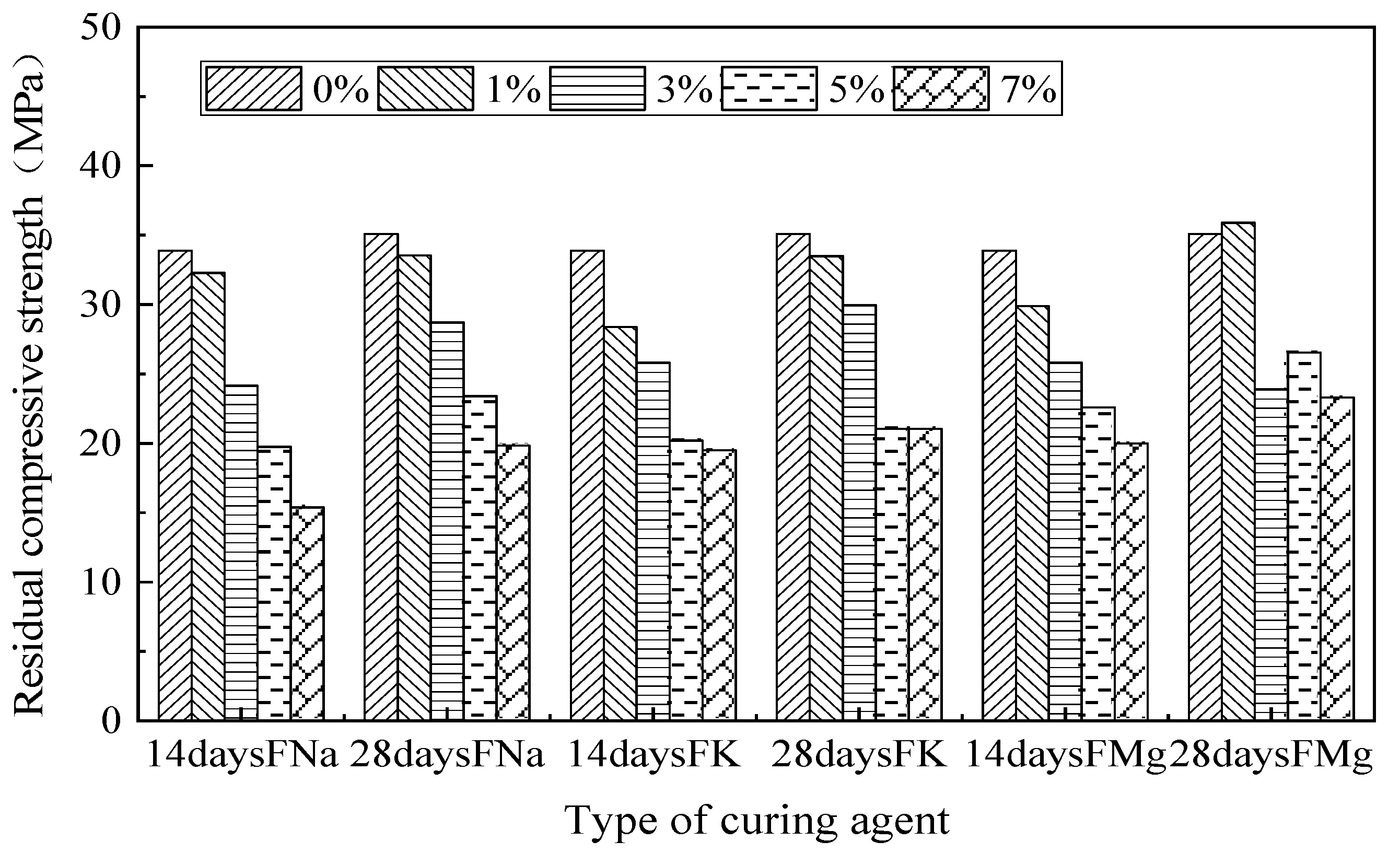
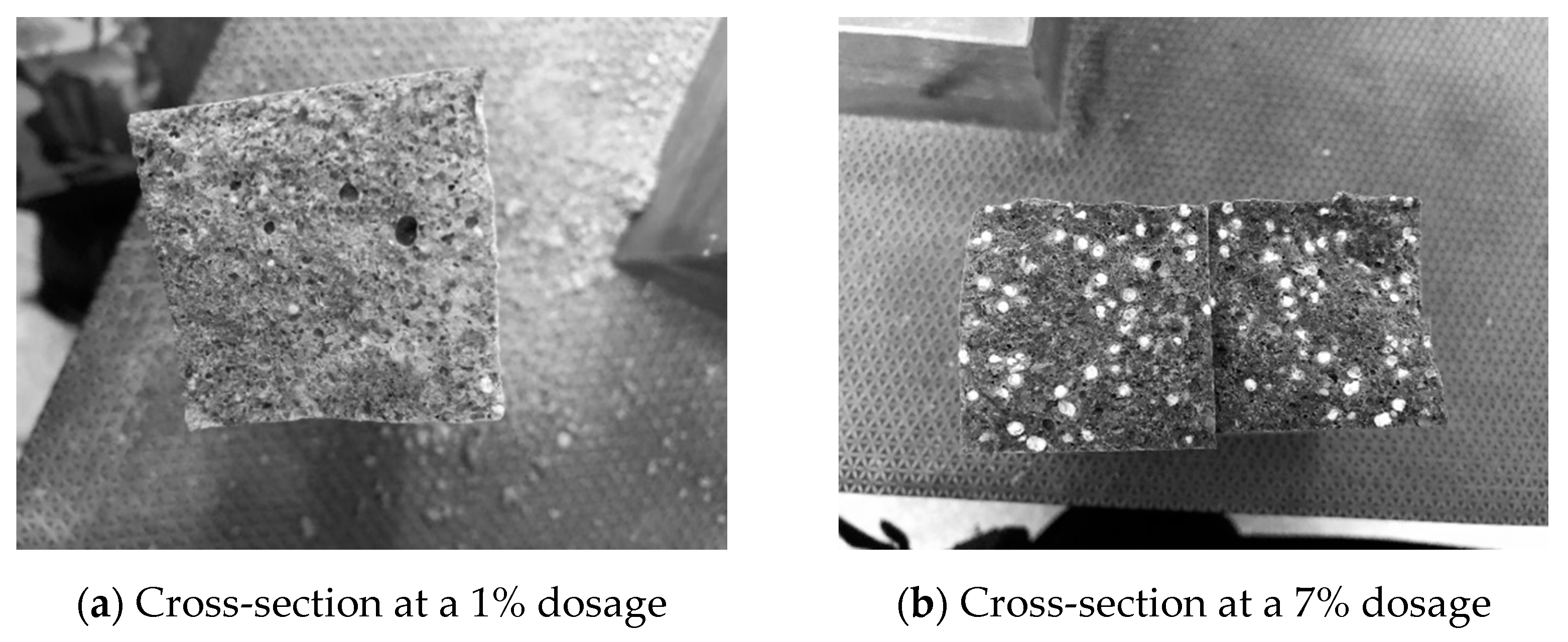
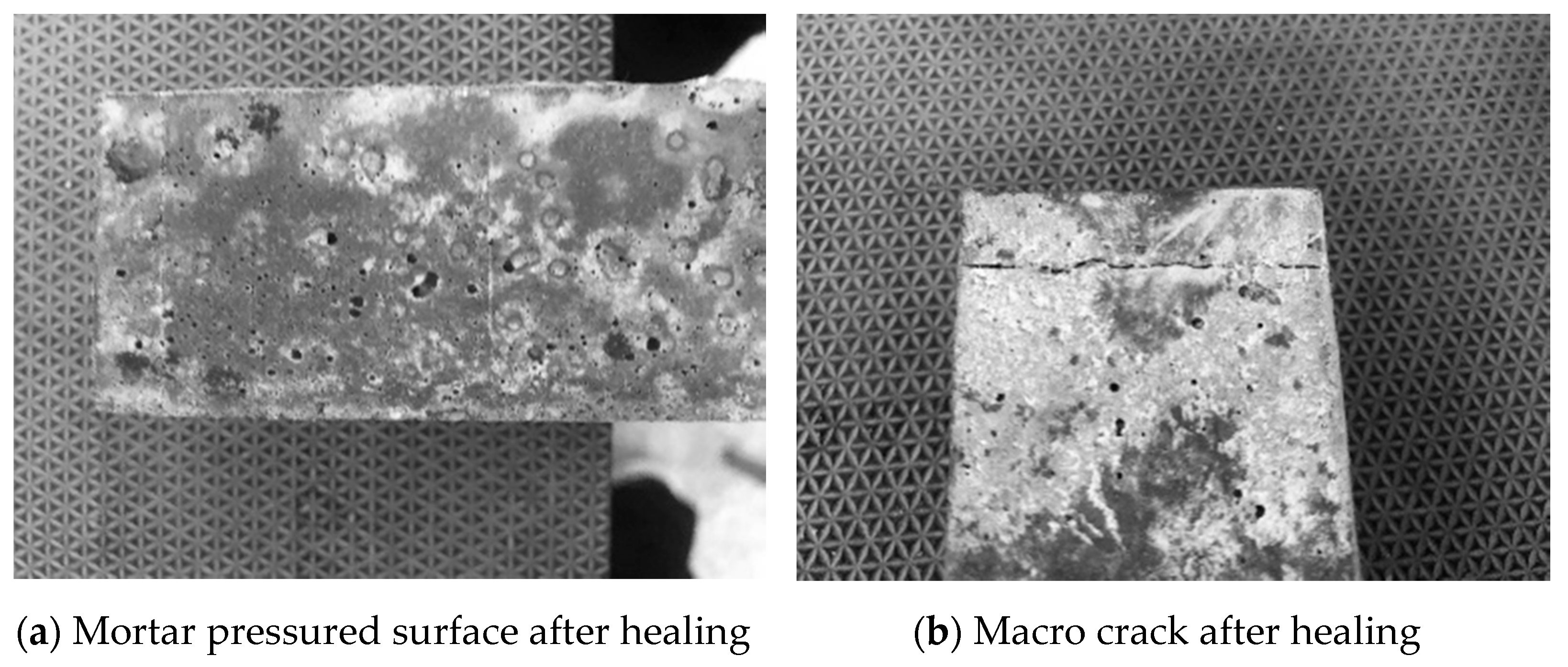

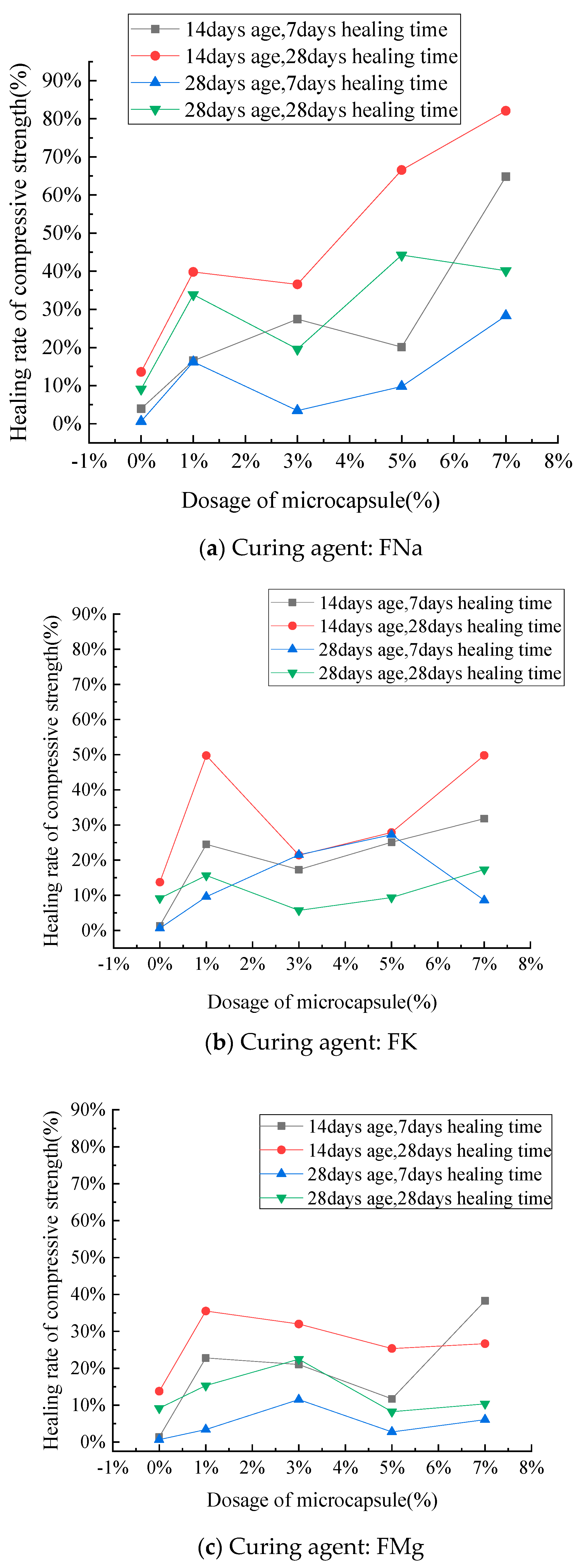
| Specific Surface Area (m2/g) | Initial Setting Time (min) | Final Setting Time (min) | Water Requirement of Normal Consistency (%) | Boiling Stability | 3 days Compressive Strength (MPa) | 28 days Compressive Strength (MPa) |
|---|---|---|---|---|---|---|
| 345 | 140 | 260 | 26.5 | qualified | 27.1 | 42.5 |
| Components | SiO2 | Al2O3 | FexOy | CaO | MgO | SO3 | K2O | Na2O | LOI |
|---|---|---|---|---|---|---|---|---|---|
| Content | 21.6% | 4.3% | 2.6% | 65.8% | 1.2% | 1.6% | 0.7% | 0.4% | 1.8% |
Publisher’s Note: MDPI stays neutral with regard to jurisdictional claims in published maps and institutional affiliations. |
© 2021 by the authors. Licensee MDPI, Basel, Switzerland. This article is an open access article distributed under the terms and conditions of the Creative Commons Attribution (CC BY) license (https://creativecommons.org/licenses/by/4.0/).
Share and Cite
Jiang, S.; Lin, Z.; Tang, C.; Hao, W. Preparation and Mechanical Properties of Microcapsule-Based Self-Healing Cementitious Composites. Materials 2021, 14, 4866. https://doi.org/10.3390/ma14174866
Jiang S, Lin Z, Tang C, Hao W. Preparation and Mechanical Properties of Microcapsule-Based Self-Healing Cementitious Composites. Materials. 2021; 14(17):4866. https://doi.org/10.3390/ma14174866
Chicago/Turabian StyleJiang, Shiping, Zhiyang Lin, Can Tang, and Wenfeng Hao. 2021. "Preparation and Mechanical Properties of Microcapsule-Based Self-Healing Cementitious Composites" Materials 14, no. 17: 4866. https://doi.org/10.3390/ma14174866
APA StyleJiang, S., Lin, Z., Tang, C., & Hao, W. (2021). Preparation and Mechanical Properties of Microcapsule-Based Self-Healing Cementitious Composites. Materials, 14(17), 4866. https://doi.org/10.3390/ma14174866





